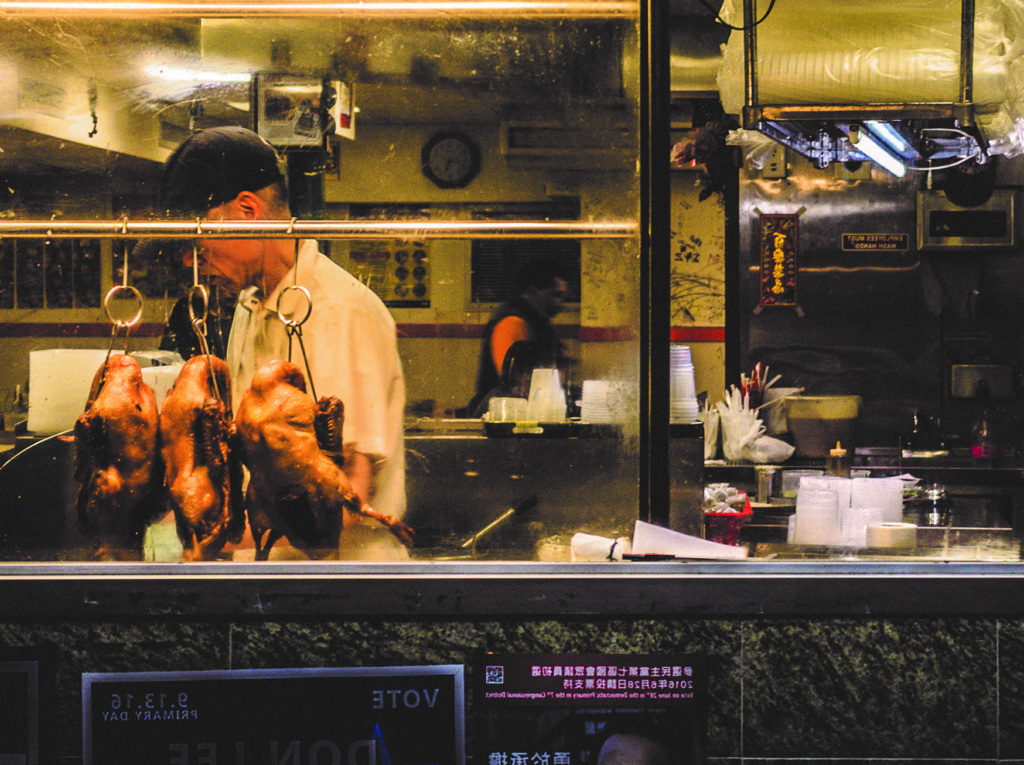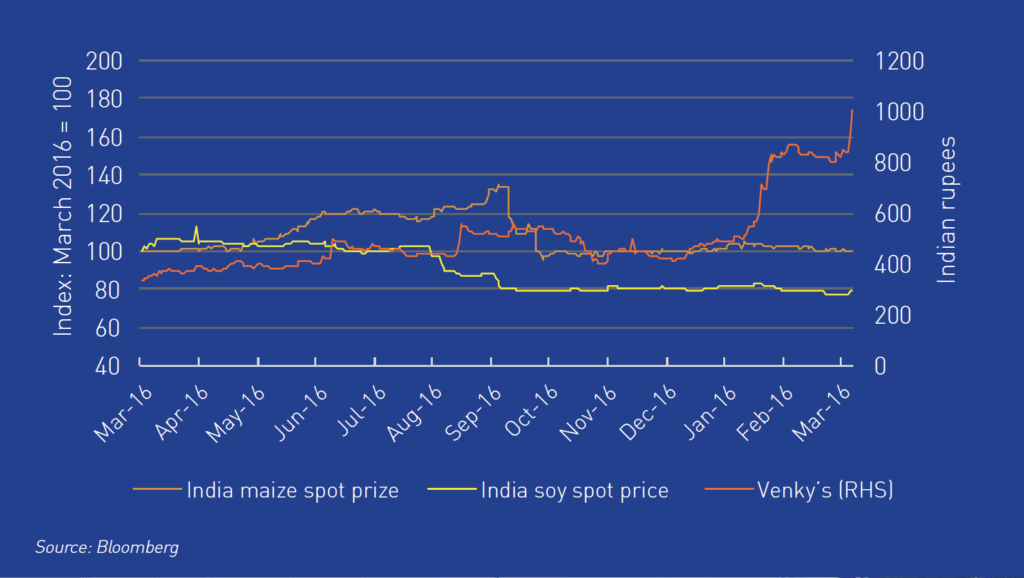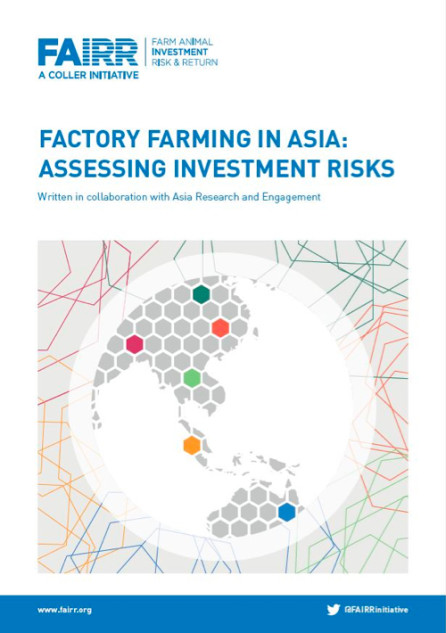Snapshot of findings
Asian meat demand is predicted to grow 19% from 2013 to 2025 to 144 million tonnes.
All three Chinese companies (Yonghui Superstores, New Hope Liuhe, Henan Zhongpin) assessed by the Business Benchmark on Farm Animal Welfare in 2017 were ranked in its bottom two tiers, as was Thailand’s CPF.
According to the World Bank, 80% of low and middle-income countries used antimicrobials for growth promotion – seen as a major cause of antibiotic resistance.
The H7N9 avian flu outbreak in China has led to 570 deaths since 2013 and resulted in a 46% fall in the value of the Guangzhou chicken price index between June 2016 and March 2017.
A pollution census from the Chinese government found agriculture was responsible for
44% more water pollution than other industrial operations. Waste from livestock was estimated at 243 million tonnes of faeces.
China already consumes almost half of the world’s antibiotics, and due to increased intensive farming. Asia is estimated toincrease antibiotic usage in chicken and pigs by 129% and 124% respectively by 2030.
Southeast Asia suffers 175,000 deaths per year from foodborne illnesses – the highest number of any global region.
Overview
When it comes to the farming sector, Asia is not necessarily the booming investment opportunity it first appears to be. While significant growth – driven by population increase and a growing middle class – is forecast for the sector, a range of poorly managed environmental, social and governance (ESG) risks also have the potential to derail returns.
This report examines 12 core Asia-Pacific markets: Australia, China (Mainland), India, Indonesia, Japan, Malaysia, New Zealand, Pakistan, The Philippines, South Korea, Thailand and Vietnam against five business-critical ESG factors.
The five ESG risks examined in this report are:
Food safety and nutrition
Food safety, including foodborne illness, food fraud and nutritional challenges, is a serious threat to public health throughout Asia and is a particularly high-profile issue in China, where several recent food safety scandals have caused serious illness, deaths and damage to brand values. Food safety incidents can affect any type of food, but they are especially prevalent in the meat and dairy sectors. For example, Yum! Brands was hard-pressed to revive its brand reputation after a food safety scandal involving the sale of tainted meat in China. Similarly, there has been no shortage of food safety scandals in Asia linked to the adulteration of food products. The most well-known is the 2008 milk scandal in China which caused the death of six children and hospitalised 54,000 more. Sanlu Group, the company at the centre of the scandal, went bankrupt – while dairy giant Fonterra, which held a 43% stake in Sanlu, faced losses of over $144 million in the wake of these events.
Processed meat is also increasingly linked to cancer and diabetes – lifestyle diseases that are on the rise across Asia. The role that nutrition can play in managing and mitigating these issues is an increasing focus for public health officials and consumers alike.
Increased health concerns regarding meat consumption, is also driving greater consumer demand in Asia for products with healthy labels, including vegan and vegetarian products.
Public health
The emergence of antibiotic resistance and the risk of livestock epidemics pose serious threats to human health. The overuse of antibiotics in livestock production is contributing to the growth of antibiotic-resistant bacteria affecting humans and animals – which could make many common diseases and infections untreatable. Meanwhile, viral infections and epidemics among livestock are increasing in frequency and severity, which is causing mass livestock culls that depress prices and lower demand. Risks of infection in humans are often higher where there are live poultry markets, which are common in Asia, as humans may come into direct contact with infected birds.
The Asian livestock industry is a major user of antibiotics and antimicrobials. According to the World Bank, veterinary antimicrobials, including antibiotics, are available in most low and middle-income countries without restriction and sold over the counter without necessary veterinary prescriptions. In 2015, 80% of these countries reported the use of antimicrobials for growth promotion. In China, the routine prophylactic use of antibiotics – many of which are critically important in human medicine – is contributing to an alarming increase in antibiotic resistance. China is already the world’s largest consumer of antibiotics and many of these are fed to animals to compensate for the poor conditions associated with intensive farming operations. In November 2015, the first instance of resistance to colistin, an antibiotic that is commonly regarded as medicine’s "antibiotic of last resort", was discovered on a pig farm in China. China is one of the world’s largest users and producers of colistin for agriculture and veterinary use.
Environmental footprint
Livestock production puts significant pressure on the environment. Beef and lamb have the highest greenhouse gas (GHG) emissions and water footprints compared to other proteins, and even chicken, the least emission-intensive meat, generates 65 times more emissions per calorie produced than legumes. As the majority of animal products’ water footprint arises from feed production rather than the water used at the production site itself, producers may experience indirect risks from water scarcity in sourcing countries when this constrains growth in feed supply.
Livestock-related pollution is also a growing problem. The Chinese government’s first pollution census in 2010 found that agriculture is responsible for 44% more water pollution than from industry operations. Water pollution from concentrated feeding operations is increasingly subject to higher regulation in China. In New Zealand, the rapid conversion of land to dairy operations is putting significant strain on local waterways. In addition to the growing risks of direct regulation on pollution, there are concerns of price volatility and continuity problems in feed supply.
Animal welfare
Consumers’ animal welfare concerns drive management practices, which leads to variations between countries. For example, there have been a number of recent news items highlighting poor animal welfare practices in Vietnam, while in India animal welfare concerns are linked to religious and cultural preferences and fundamental to the structure of the market. In Australia, animal deaths arising from live exports and poor treatment in destination countries have triggered export bans, federal reviews and revocation of company licenses. There is also growing momentum behind higher welfare farming in China, and animal welfare concerns are becoming increasingly important for exporters.
Labour standards
Concerns over labour standards have grown in recent years, with suppliers found to have poor labour standards facing significant reputational and trade risks. For example, in 2014 news reports exposed numerous human rights abuses in Thailand’s seafood supply chains. As a result, the EU threatened to ban seafood imports from Thailand. The country has also faced similar issues in the livestock sector. In 2015, two Scandinavian organisations, Swedwatch and Finnwatch – funded by the Swedish government and the European Union – interviewed 98 foreign workers from four poultry producers that had exported to Sweden and found that all factories had clear breaches of international standards.
This is set to be subject to increased scrutiny, as consumer awareness grows and requirements relating to labour including within the supply chain evolve. For example, both the UK and Australia have introduced Modern Slavery Acts which compel companies to take action to monitor, minimise and mitigate the chance of modern slavery occurring in their supply chains.
"How Asia responds to ESG risks in the coming years will be a defining factor in whether the region can satisfy investor appetite."
Jeremy Coller, Founder, FAIRR Initiative and CIO, Coller Capital
Threats in Asia have implications for the global supply chain. For example, 35% of Brazil’s total soybean production was imported by China in 2016 for animal feed and this figure is increasing. This rise in soybean demand is encouraging deforestation in Brazil – with potentially enormous consequences for global carbon budgets. China’s shift towards more intensive farming practices is driving up antibiotic use, just as there is a global push to reduce usage in the face of antibiotic resistance.
Despite the risk, there are also exciting opportunities emerging in Asia’s agriculture sector. Innovative companies are investing in research and development to create sustainable food products including alternative proteins. Filipino food giant, Monde Nissin, points out that the meat alternatives market is currently concentrated in Europe and North America, with barely 12% to 15% in Asia – hence creating an enormous market opportunity in an industry predicted to reach $5.2 billion by 2020.
Implications for investors
Food safety
Individual companies suffer most when there is contamination or a lapse in controls that results in food safety risks for customers. It is critical that investors ensure that the companies with whom they invest have the management controls in place to avoid such quality and safety scandals. More broadly, while the new wave of middle-class Asian consumers currently seem willing to spend on meat, dairy, fish and eggs, they are also better informed on the downsides of meat consumption, particularly around nutrition and food safety. An increase in such consumer awareness has the potential to significantly impact long-term demand, with several companies already diversifying into plant-based proteins.
Public health
Antimicrobial resistance is a serious global health issue. Failure to ensure the prudent use of antibiotics could result in the rise of antibiotic-resistant superbugs that have the potential to undermine modern medicine, cause hundreds of thousands of deaths and cost the global economy $100 trillion in lost output by 2050. Simultaneously, the growing effort to restrict the use of antibiotics is likely to impact productivity in Asia, at least in the medium term, as companies and suppliers will need to adjust their production methods and may face lower efficiency. As awareness of the antibiotic resistance risk increases, producers and investors will also need to be sensitive to changing customer demand for antibiotic-free animal products.
It is also highly probable that viral outbreaks leading to huge culls and depressed prices will continue to impact producers in the coming years. Exports are often banned from an entire country when there is an outbreak. Companies that vigorously uphold standards may have added protections from viral infections, though they can still be subject to price risk and may have their exports barred where an outbreak impacts a domestic peer.
Environmental footprint
Environmental issues can create multiple pressures for livestock producers that can crystallise in different ways, presenting growing risks for industry and investors. Local-area pollution, such as pollution to waterways and damage to land has perhaps the highest regulatory risk, as it links with human health issues and is traceable directly to producers. Investors have seen regulatory action in developed markets on this issue – for example, in 2007, North Carolina permanently banned new pig factory farms to protect watercourses and prevent pollution. And the direction of travel in China and other parts of Asia suggests similar action may emerge in the region.
The Asian livestock sector is also highly exposed to regulations designed to foster a low-carbon transition. Animal products, especially beef and ruminants, are heavily linked to GHG emissions. If China introduces a national emissions trading scheme and possible carbon tax on emissions in the coming years then this will significantly impact the sector. Water scarcity and drought are risks that can constrain growth in several parts of Asia. Livestock producers face direct weather-related risks, such as flooding or heat stress, all of which are projected to increase due to climate change. Feed supply pressures can also lead to input cost volatility, the risk to business continuity, and reputational risk.
Animal welfare
There are a number of ways in which animal welfare can change the landscape for companies:
consumer substitution to plant-based proteins;
consumer preference for higher-welfare labelled products;
major buyers implementing higher welfare in their sourcing policies;
national import/ export barriers due to animal welfare concerns, and;
higher regulatory standards in domestic markets.
We expect these trends to strengthen over time. Farm animal welfare has emerged strongly as a regulatory issue in developed markets over the last decade. In the US, several states, including California and Massachusetts, have introduced legislation banning the extreme confinement of calves, sows and hens. For example, last year Massachusetts became the first US state to pass a ballot measure that would prevent operations that confine calves, sows and hens from even selling their products in the state, and it passed with 77.7% of the vote – the most of any animal ballot measure in history.
Cross-border trade is also affected by farm animal welfare considerations. The Australian government has imposed temporary bans on live cattle exports to Indonesia and Vietnam due to cases of mistreatment and abuse. In one case this caused significant disruption to the Australian cattle industry, leading to a class-action lawsuit against the government seeking AUD 600 million ($448 million). In 2018, the Australian government revoked the license of Emmanuel Exports following reports that 2,400 sheep died of heat stress on international transit. The company is now under criminal investigation.
Labour standards
Requirements relating to labour are evolving in the region. It is likely that concerns will continue to materialise from reputation-sensitive customers, such as European importers or multinationals with operations in Asia. These issues can also crystallise in domestic markets, whether through increased regulation, domestic reputational problems, legal risks or even strikes in some countries. Continuing problems with labour standards may also raise concerns over quality of management in general.
Case studies
Yum! China demerger follows food safety failure

For many years, Yum! Brands paved the way as a rare example of an American company that had successfully entered the Chinese market. By 2014, Yum! Brands had become the leading fast food operator in China, with more than 7,200 KFC and Pizza Hut restaurants.
In 2012 Yum! Brands was accused of feeding chickens extremely high levels of growth hormones and antibiotics, which did not materially affect the company. However, a further governance scandal including evidence of workers at a supplier company using expired meat followed in 2014.
Between July and October 2014, Yum! Brand’s share price dropped 8.29%, wiping $3.6 billion off the company’s value. Yum! Brands opted to separate out its China business into Yum! China, which required a significant effort. Following unsuccessful negotiations with China Investment Corp and KKR, it was eventually spun off to two Chinese investment groups in November 2016.
Antibiotics in feed, resistance in bacteria

Vietnam faces a huge problem with antibiotics use in agriculture. A study of 1,462 commercial pig feeds available in the country showed that over half contained antimicrobials – and that 286.6 mg of antimicrobials were used to produce one kg of pork. This is more than five times the UK recommended target of 50 mg/kg.
When Salmonella samples from poultry were tested for resistance to antimicrobials, bacteria showed high levels of resistance to specific drugs. More than half of samples from Bangladesh and Thailand showed resistance to the broad spectrum and commonly used antibiotic Tetracycline.
Feed supply risks and opportunities

Livestock companies rely on a steady supply of feed to grow animals. This input makes up a significant component of overall costs. However, rising pressures including limited land, natural hazards, deforestation, the cost of fertilisers, herbicides and pesticides, and constraints on water availability mean that prices for animal feeds are increasingly volatile. This price volatility can have significant impacts for livestock producers.
Venky’s, a leading integrated poultry group in India, is a good example of how companies are vulnerable to this price volatility. Venky’s has three segments: poultry and poultry products, animal feeds and oilseed. The company’s share price and profit are also dependant on the cost of feeds such as soy and maize.
In 2016, Venky’s performance significantly rebounded from an INR 18 million ($278,000) loss in quarter one, to an INR 540 million ($8.3 million) profit in quarters two and three. The financial statements do not allow for a full analysis of the cost structure for the separate businesses; however, the declines in input prices, which form a significant component of the costs, played a significant role in improving the company’s margins. The chart below shows Venky’s price (right-hand side) alongside the prices of two significant feed components – soy and maize.

Venky’s stock price and main input market prices

